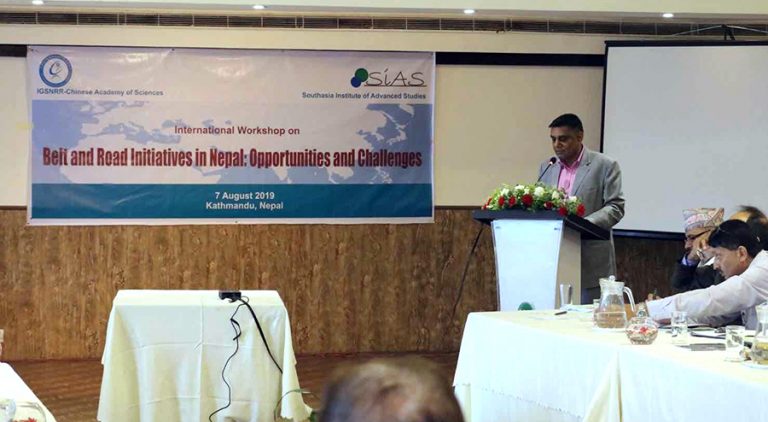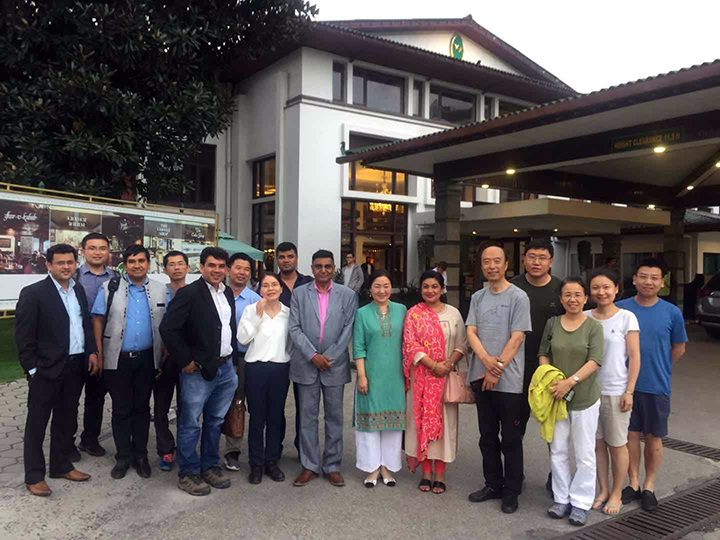
10 August 2019, Kathmandu
The Former Minister for Culture, Tourism and Civil Aviation Mr. Anand Pokharel has expressed his honor and privilege to be the Chairperson of the international workshop on Belt and Road Initiatives in Nepal: Opportunities and Challenges held in Kathmandu on Wednesday 7th August, 2019. At the outset, Pokhrel expressed his gratitude to the Chinese Academy of Science, Beijing China and South Asia Institute for Advanced Studies (SIAS), Kathmandu for extending invitation and giving opportunity to share his views in the conference.
The Belt and Road Initiative is a visionary undertaking of Chinese President Xi Jinping launched in 2013 that has brought extraordinary opportunities for not only China, but also for the partners around the globe. It is a significant milestone that aims at boosting connectivity that will remove the barriers for the seamless movement of people, goods and services among 1.4 billion people of China, 1.8 billion people of South Asia and more than 600 million people of South East Asia. Moreover, the benefit countries can derive with the improved connectivity networks among the countries in the region by integrating their markets, and promoting tourism, trade, investment and innovation will be immense. It is a matter of satisfaction that trade, investment, cultural, political and people to people exchanges between Nepal and China if the largest source of FDI, second largest trading partner, and second largest source of tourism of Nepal. The growth rate of tourist arrival from China to Nepal during 2018 was almost 47%. But, with the growing rate volume, the trade gaps is also widening. Therefore, Nepal is seeking China’s support for promoting concessional market access in China, transferring technology and enhancing production capacity of Nepal. After the establishment of diplomatic relations in 1955 both the countries have been carrying forward their time-honored and trouble free relations based on mutual trust, understanding and good neighborliness.
In spite of numerous geopolitical hurdles, Nepal has signed the Memorandum of Understanding on BRI on 12 March 2017 in the ground created by the landmark first visit by Nepal’s Prime Minister KP Sharma Oli on 23 March 2016. The recent state visit of President Rt. Hon. Bidhyadevi Bhandari during the second BRI forum for International Cooperation, the visit of Prime Minister Rt. Hon. KP Sharma Oli to China in 2018, and several other high level visits both ways in the recent years have elevated out relations to newer heights.

The trans-Himalayan BRI encompasses the cross-border road networks, the railway lines, oil pipelines, information highways, energy grids, skyways and transmission highways. This initiative aims at utilizing the rich resources along the Himalayan range, and improving the quality of lives of peoples in the entire Himalayan region. It will create a new connectivity for the long-term investment and growth and also at the same time allow for the revitalization of the Himalayan region with its own plan for prosperity informed by unique Himalayan cultural, ecological and social features.
Nepal adheres to one China policy and practices unflinching commitment for not tolerating any anti-Chinese activities in her soil. On the other hand, China has always supported Nepal’s sovereign independence, territorial integrity, and peace and is also providing much needed development assistance without preconditions. Nepal and China enjoy exemplary relations existing between the countries of different sizes and social systems anywhere in the world. One of the most ancient nation-states in the world, Nepal is endowed with amazing natural,cultural and historical heritage. Even though it accounts for only 0.1% of the global landmass Nepal has 8 of the tallest 14 peaks on earth including the Mount Everest, 600 indigenous plant families, 8% of the total population of birds, and 4% of the mammals on earth. Nepal is considered as open zoo and Kathmandu valley is a living heritage museum. It is a land of living goddess, the Kumari and the birth place of Shakyamuni Buddha. The TRIP Advisor, Lonely Planet, Rough Guide, BBC, CNN have rated Nepal as the best value of money destination, in several consecutive years in the past including the year 2019. The year 2020 has been declared as Visit Nepal Year and Minister Pokhrel also wished to invite the people from China to visit Nepal and enjoy it.
In the workshop, Professor Dinesh Poudel, SIAS welcomed and presented the objectives of the workshop presenting on “The Himalayan BRI-A historic opportunity for Nepal.” Similarly, Professor LIU Weidong, CAS Beijing welcomed and presented on “A discursive Construction of the Belt and Road Initiative”. Professor Khadga KC, TU Kathmandu also presented on BRI and policy Coordination between Nepal and China while associate professor Mrigendra Karki from CNAS TU stated his view on BRI and political processes in Nepal. In addition to this, professor Wang Jiaoe , CAS Beijing presented on Infrastructure connectivity of the BRI and Professor Zhang Linxiu on Ecosystem Based Adaptation to Climate Change through sustainable natural resource management. On the other hand, Kalyan Roka presented on BRI and Himalayan Connectivity and Professor HU Yunfeng , CAS Beijing on “Ecological Carrying Capacity Assessment in the Tibet Plateau and China-Nepal Corridor Region”.










